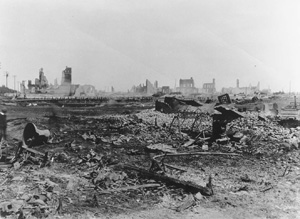FARGO, NORTH DAKOTA

Aftermath of a fire in Fargo, North Dakota, June 7, 1893
View largerFargo, located in east-central North Dakota on the banks of the Red River, is the largest city in North Dakota, with a population of 90,599 in 2000, an increase of 22 percent over 1990. Adjacent cities include Moorhead, Minnesota (population 32,177), and West Fargo, North Dakota (estimated population 14,940). The population of the Fargo-Moorhead metropolitan statistical area (Cass County, North Dakota, and Clay County, Minnesota) is 174,367.
Fargo sits on clay-loam soil from ancient Lake Agassiz, which resulted from melting glaciers 12,000 years ago. The soil's fertility and depth drew settlers to the region's bonanza farms of the late 1800s. Fargo served as a railroad distribution point for new settlers and as a grain-shipping terminal. The city, platted in 1871 and incorporated in 1874, was named after William G. Fargo, a Northern Pacific Railroad director and founder of the Wells-Fargo Express Company. In 1885 Fargo had a population of 7,394, and by 1920 it was the largest city in North Dakota, with 21,961 people.
Fargo is the seat for Cass County and is host for several state and federal government facilities such as the new federal courthouse, named after U.S. senator Quentin Burdick. It is served by the Burlington Northern and Santa Fe Railway, Amtrak, and the Hector International Airport and is at the intersection of Interstates 29 and 94. Fargo hosts 4,056 business establishments. The adjacent cities of Moorhead, with 1,101 businesses, and West Fargo, with 550 businesses, bring the area total to 5,707 establishments. Although agriculture is a dominant industry, other industries also are vital to the area's economy. For example, Fargo is a regional health-care center, with three medical facilities: Dakota Heartland Health System, MeritCare Medical Center, and the Veterans Affairs Medical Center. Other major employers include North Dakota State University, Blue Cross Blue Shield of North Dakota, American Crystal Sugar Company, Great Plains Software, First Bank System, and Case Corporation.
About 30 percent of the city's employment is in the service industry, followed by wholesale and retail trade with 29 percent (the West Acres Shopping Mall is a regional draw). The remaining employment is in government, manufacturing, mining, construction, finance, insurance, real estate, transportation, utilities, and communications. Fargo and Moorhead together have a labor force of 103,120 employees, with 99,950 in nonagricultural employment.
The area is home to several colleges, universities, and vocational schools. North Dakota State University is the state's land-grant university, with a student enrollment of over 9,600. Minnesota State University–Moorhead has an enrollment of 6,700 students. Concordia College, a Lutheran liberal arts college, has nearly 3,000 students. Northwest Technical College–Moorhead provides training for 1,400 students. The area's primary and secondary public school system serves nearly 22,700 students. In addition, there are nine private and parochial school facilities that serve more than 2,000 students.
Churches and religious institutions play an important role in the community. There are about 125 congregations in the Fargo- Moorhead area, with about 32 percent of the members in Catholic churches, 49 percent in Lutheran churches, and the remaining 19 percent in churches of other denominations. Additionally, there are two Jewish synagogues and meeting places for those of other faith traditions.
Fire destroyed almost the entire city on June 7, 1893, and floods have plagued Fargo, including one in 1897 and another in 1997. These events resulted in rebuilding booms that shaped the city's architecture. A tour of the city's homes and buildings reveals Classical Revival architecture from the postfire construction, Richardsonian Romanesque in many of the downtown buildings constructed after the turn of the century, and Art Moderne in buildings from the mid-1920s to 1940. Popular vernacular styles and period revivals can be seen throughout residential neighborhoods.
The FargoDome is the largest indoor multipurpose facility in the Northern Plains and hosts athletic events, concerts, trade shows, and conventions. Bonanzaville, U.S.A., adjacent to the Red River Valley Fairgrounds, is a reconstructed pioneer town with turn-of-the-century houses and stores. The Heritage- Hjemkomst Interpretive Center in Moorhead, with a replica Viking ship and Norwegian stave church, highlights the area's Scandinavian heritage. Other facilities include the Plains Art Museum and Red River Zoo.
Fargo is home to the Fargo-Moorhead Symphony, which presents symphonic and chamber orchestral works, and the Fargo- Moorhead Community Theatre, which offers plays and theatrical training. Sports teams include the Beez (minor-league basketball), the Ice Sharks (hockey), the RedHawks (minor-league baseball), and the Fargo Freeze (indoor football). The community's artistic and sports atmosphere has produced celebrities like singer Bobby Vee and baseball player Roger Maris.
Several magazines and organizations have ranked Fargo-Moorhead in lists of the most kid-friendly, best small place to live, safest, best place to raise a family, best for working mothers, and best place to start a career.
See also MUSIC: Vee, Bobby / WATER: Floods.
Gary A. Goreham North Dakota State University
Crossings: A Photographic Document of Fargo, North Dakota. Fargo: Institute for Regional Studies, North Dakota State University, 1995.
Roberts, Norene A. Fargo's Heritage. Fargo ND: Fargo Heritage Society, 1983.
Previous: Edmonton, Alberta | Contents | Next: Fort Worth, Texas
XML: egp.ct.022.xml
